Toucan Profile
For those of us who grew up in the sideways rain, the perpetual milky light of an overcast summer and single-digit indoor temperatures, the captivating colours and fragrances of artificially sweetened “tropical” juice drinks were a memorable treat and seeded in some of us a deep yearning for the exotic neotropical paradises they promised.
And if there was any animal more suited to be plastered on everything containing that magic combination of pineapple extract and GFS it would have to be the juicyfruit-coloured toucan.
But in reality, this bird is much more than just a mascot for childhood obesity, it’s a key player in a declining ecosystem.
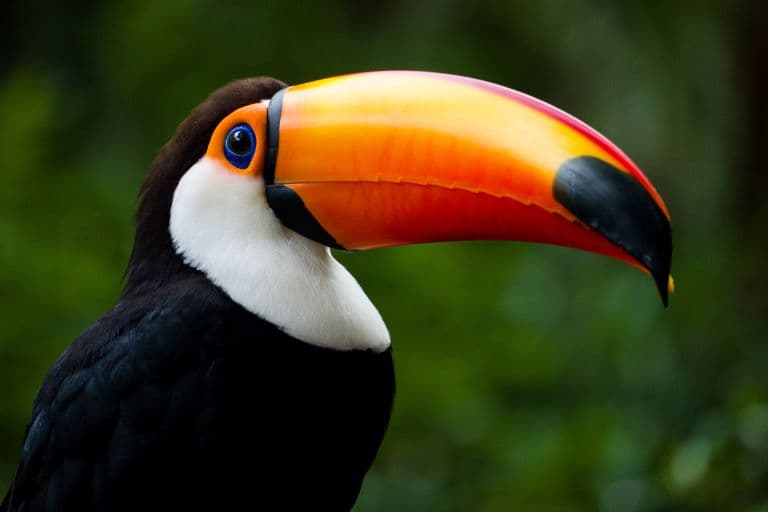
Toucan Facts Overview
| Habitat: | Forested areas, often high altitude |
| Location: | From |
| Lifespan: | 20+ years in the wild |
| Size: | From 29 cm (11 in) to 63 cm (25 in) depending on species |
| Weight: | Smallest 130 g (4.6 oz), largest 680 g (1.50 lb) |
| Colour: | Varied, vibrant colours, purple, white, yellow, scarlet, and black |
| Diet: | Mostly fruit, sometimes eggs and smaller vertebrates |
| Predators: | Eagles, snakes, monkeys |
| Top Speed: | Unknown, slow |
| No. of Species: | 40+ |
| Conservation Status: | Ranging from Least Concern to Endangered (IUCN) |
Toucans are more than the stereotypical logo, they’re a whole family of incredible birds with big noses that champion a niche seen all over the world.
They’re surprisingly diverse, though for the most part, they are all flamboyant in their own way, and carry an incredible nose that’s interesting in its use and structure.
Inside the beak is another peculiar organ, and the other end of this bird is a bit unusual, too. All in all, these are eccentric and extremely significant birds who help protect some of the most important forest ecosystems on Earth.
Interesting Toucan Facts
1. They come in all colours
Toucans are members of the Piciform order, along with the woodpeckers. This goes some way to explaining some of the quirks they’re known for, as well as their strange feet, which are zygodactyl, with two toes forward and two back.
Toucans make up the family Ramphastidae, which sounds like advice you’d give a male sheep on his first day of head-butting school and contains at least 40 species in five genera.
The stereotypical toucan seen in cartoons and various other media stems from just one of the 40 or more species in this family, likely the toco or keel-billed toucans, large birds with brightly coloured beaks, yellow throats and black and white plumage.
But there is a significant range in size and colour in these birds, some looking more like kingfishers in their colouration, others like jays or barbets, the latter of which share an infraorder with toucans and are close cousins.
The smallest is the Lettered aracari, a mere handful of toucan weighing around 100g, the largest, the toco toucan, weighs well over half a kilo and is more than 60cm long.
As different as they are, they all have enormous beaks and pretty colours and they’re all quite nice birds in general.
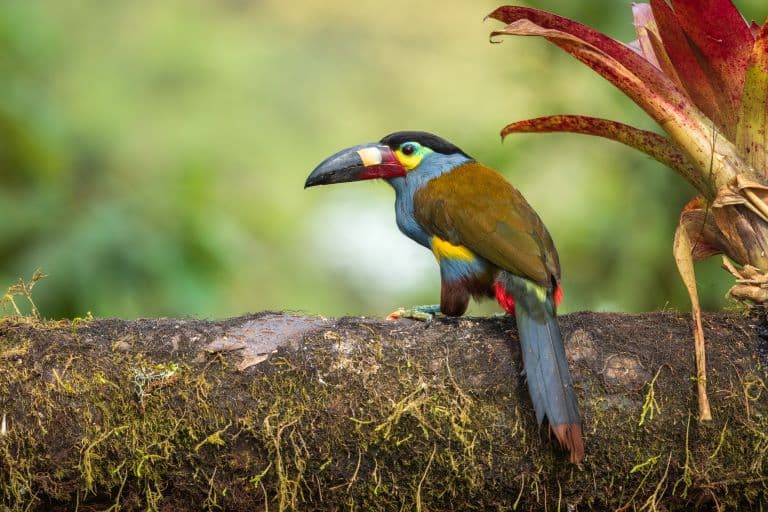
2. They’re very playful
One immediately obvious use of this enormous nose is in playful combat, and toucans seem to enjoy spending time in groups of up to twenty, sparring with their beaks, chasing one another, making a lot of noise and generally enjoying life.
These behaviours help maintain bonds between the birds and look like a lot of fun, too. When they’re enjoying themselves they can be heard making a rapid clicking noise, very similar to the purring a cat uses to trick you into a false sense of security. 1
3. They eat more or less anything
These are primarily fruit-eating birds, and they live in the best place in the world for that. But as most animals, they enjoy a dose of high protein every now and then, and where the fruit is lacking, eggs, lizards and small birds can pick up the slack.
In general, they don’t hunt, but will pick up opportunities where they arise, and could be considered opportunistic omnivores.
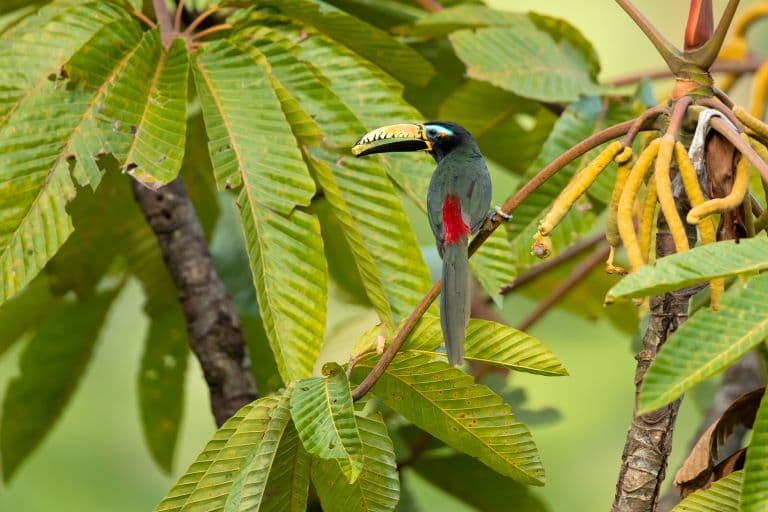
4. They have weird tongues
Toucan tongues are a peculiar organ. Their familial ties to woodpeckers come out here, too, as the tongue is long and feathered like their head-banging counterparts.
They have bristles along the tongue, possibly to help taste food, but more likely to aid in insectivorous snacking; and many have serrated beaks that help grip and manoeuvre food items before swallowing them. 2
5. Their beaks are radiators
All of this engineering is housed in one of the most iconic bills of any animal after the platypus. These huge protrusions are surprisingly lightweight, made of a lattice-like structure that keeps them strong and stiff without adding too much weight.
The beak is made of spongy keratin, the same protein responsible for hair, fingernails and traditional boner medicine by misguided shamans.
This radiator-like structure can be used as just that – it’s a thermoregulation organ, able to increase or decrease the body temperature of the bird by opening and closing blood vessels inside it. 3
6. And weird tails
At the other end of the bird is a structural anomaly that isn’t seen in any other avian: a fused string of tail vertebrae on a ball joint.
This gives the toucan a unique ability to hinge its long tail back over its head, which it seems to enjoy doing while sleeping. 4
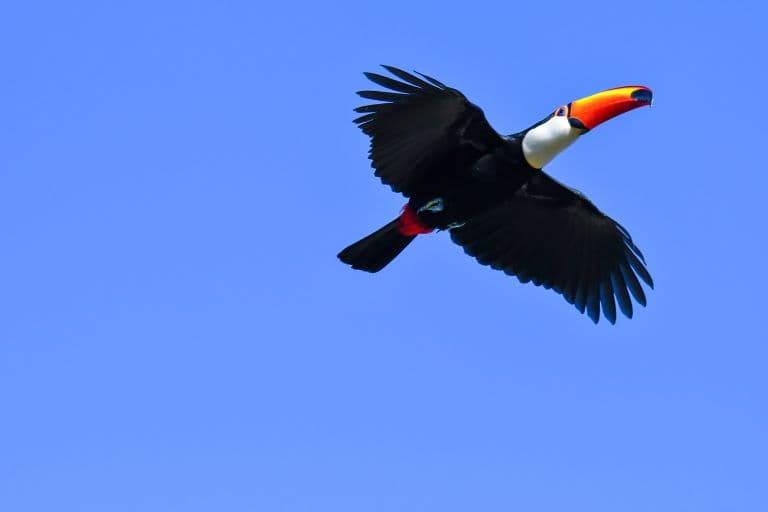
7. They’re the hornbills of the Americas
Behaviourally and morphologically, toucans are remarkably similar to the Hornbills of Africa.
And this is no coincidence, though it is quite a special quirk of evolution. The two lineages aren’t related closely at all, and all of the similarities evolved independently, but in response to very similar ecological pressures.
So, while they have very different DNA, both hornbills and toucans evolved to solve similar problems using similar adaptations in a process known as convergent evolution.
8. But they’re restricted to primary forest
Unlike many hornbill species, however, toucans are more reliant on untouched, primary forest ecosystems. This puts them at a disadvantage when it comes to logging and habitat destruction, and even reforestation since the newly protected forest will take decades to hundreds of years to mature.
Sadly, at least one species of toucan, the yellow-browed toucanet, has lost much of its forest home to cocoa plantations and is now on the endangered list.
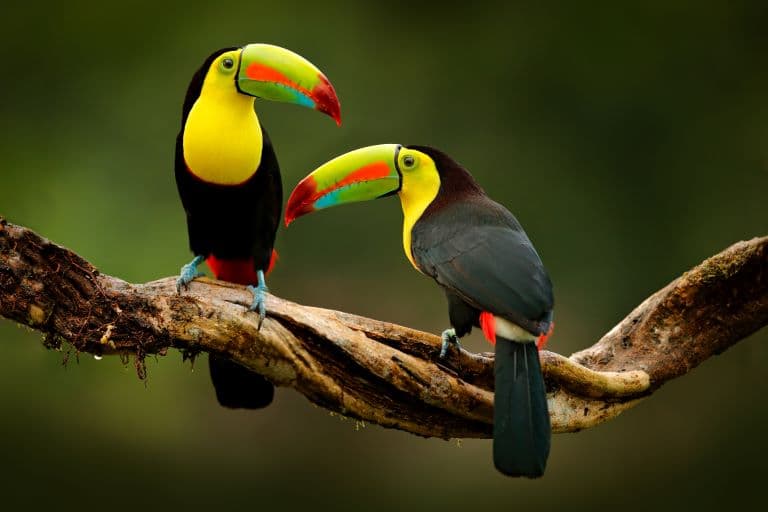
Toucan Fact-File Summary
Scientific Classification
| Kingdom: | Animalia |
| Phylum: | Chordata |
| Class: | Aves |
| Order: | Piciformes |
| Family: | Ramphastidae |
Fact Sources & References
- Cuddle Buddies (2023), “Rescue Toucan Grows Into Curious And Quirky Bird”, Youtube.
- (2014), “Toucan Tongues…and bill development”, Teifi Ringing Group.
- (2009), “Toucans use their enormous bills to keep their cool”, The Guardian.
- “Toucan”, biology dictionary.
